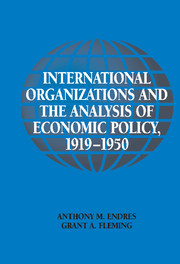Book contents
- Frontmatter
- Contents
- List of Figures and Tables
- List of Abbreviations
- Preface
- 1 Economics and Policy in International Organizations: Introduction
- 2 Business Cycles: Conceptions, Causes, and Implications
- 3 The Role and Conduct of Monetary Policy in the 1920s and 1930s
- 4 Public Investment Programs in the Interwar Period: Pre-Keynesian, Proto-Keynesian, and Keynesian Perspectives
- 5 Trade Policy Research: Geneva Doctrine and the Scandinavian Connection
- 6 Social Economics at the ILO: Scope, Content, and Significance
- 7 International Finance and Exchange Rate Policy
- 8 The Full Employment Movement from the 1940s
- 9 Conclusion
- References
- Index
7 - International Finance and Exchange Rate Policy
Published online by Cambridge University Press: 29 July 2009
- Frontmatter
- Contents
- List of Figures and Tables
- List of Abbreviations
- Preface
- 1 Economics and Policy in International Organizations: Introduction
- 2 Business Cycles: Conceptions, Causes, and Implications
- 3 The Role and Conduct of Monetary Policy in the 1920s and 1930s
- 4 Public Investment Programs in the Interwar Period: Pre-Keynesian, Proto-Keynesian, and Keynesian Perspectives
- 5 Trade Policy Research: Geneva Doctrine and the Scandinavian Connection
- 6 Social Economics at the ILO: Scope, Content, and Significance
- 7 International Finance and Exchange Rate Policy
- 8 The Full Employment Movement from the 1940s
- 9 Conclusion
- References
- Index
Summary
INTRODUCING NURKSE'S PIVOTAL WORK ON CURRENCIES AND INFLATION
Modern literature is replete with economic histories documenting international financial “crises,” causes of crises, and lessons from policy responses with the 1920s and 1930s often given prominence. Studies concentrating on episodes of international monetary reform, the history of international monetary standards, and proposed new monetary orders also abound. In all of this literature scant attention has been accorded to the doctrinal development of research work completed within and for international organizations. Retrospectives available for the period from 1920 to 1950 are quite specific; they recount proposed arrangements for international economic cooperation and alternative monetary orders – that is, frameworks in which the international monetary system might operate – concentrating exclusively on the minutiae of negotiation over the Bretton Woods agreement in particular (for example, Eichengreen 1994; Gardner 1969; James 1996; Mikesell 1994).
The 1940s was widely conceived as a unique opportunity for reconstructing the international monetary order and gave rise to an array of intellectual constructs significantly different from the Keynes and White Plans – plans forming the basis for discussion at Bretton Woods in 1944 and for the final Bretton Woods agreement. In this chapter we examine the research of the LON and BIS on international finance and exchange rate policy in the 1940s, making Ragnar Nurkse's especially neglected work for the LON our primary focus.
- Type
- Chapter
- Information
- Publisher: Cambridge University PressPrint publication year: 2002

